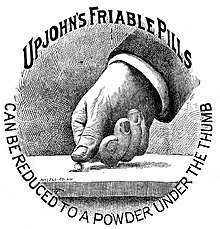Upjohn
 | |
| Industry | Pharmaceutical |
|---|---|
| Founded | 1886 |
| Fate | Merged with Pharmacia to form Pharmacia & Upjohn |
| Headquarters | Michigan, United States of America |

The Upjohn Company was a pharmaceutical manufacturing firm founded in 1886 in Kalamazoo, Michigan, by Dr. William E. Upjohn, an 1875 graduate of the University of Michigan medical school. The company was originally formed to make friable pills, which were specifically designed to be easily digested.[1] These could be "reduced to a powder under the thumb", a strong marketing argument at the time.
In 1995, Upjohn merged with Pharmacia AB, to form Pharmacia & Upjohn.[2]
Chemistry

Upjohn developed a process for the large scale production of cortisone. The oxygen atom at the 11 position in this steroid is an absolute requirement for biological activity. There are however no known natural sources for starting materials that contain that feature. The only method for preparing this drug prior to 1952 was a lengthy synthesis starting from cholic acid isolated from bile. In 1952 two Upjohn biochemists, Dury Peterson and Herb Murray announced that they were able to introduce this crucial oxygen atom by fermentation of the steroid progesterone with a common mold of the genus Rhizopus. Over the next several years a group of chemists headed by John Hogg developed a process for preparing cortisone from the soybean sterol stigmasterol. The microbiological oxygenation is a key step in this process.[3]
Subsequently, Upjohn together with Schering biochemically converted cortisone into the more potent steroid prednisone by a bacterial fermentation.[4][5] In chemical research, the company is best known for the development of the Upjohn dihydroxylation by V. VanRheenen, R. C. Kelly and D. Y. Cha in 1976.[6] Upjohn's most well-known drugs before the acquisition by Pfizer were Xanax, Halcion, Motrin, Lincocin, and Rogaine.
See also
References
- ^ Kalamazoo Public Library - Local History - William E. Upjohn: Person of the Century 1853 - 1932 (Internet Archive)
- ^ Resource Informagen (Internet Archive)
- ^ Hogg, John A. (1992). "Steroids, the steroid community, and Upjohn in perspective: A profile of innovation". Steroids. 57 (12): 593–616. doi:10.1016/0039-128X(92)90013-Y. PMID 1481225.
- ^ http://www.prednisonesideeffects.org/prednisone-half-life-is-a-good-medicine/[full citation needed]
- ^ http://dailymed.nlm.nih.gov/dailymed/drugInfo.cfm?id=3735[full citation needed]
- ^ Vanrheenen, V.; Kelly, R.C.; Cha, D.Y. (1976). "An improved catalytic OsO4 oxidation of olefins to cis-1,2-glycols using tertiary amine oxides as the oxidant". Tetrahedron Letters. 17 (23): 1973–6. doi:10.1016/S0040-4039(00)78093-2.)
- Upjohn Co. v. United States (449 U.S. 383) (1981)
External links
- Companies based in Kalamazoo, Michigan
- Pharmaceutical companies established in 1886
- Defunct pharmaceutical companies of the United States
- Pfizer
- Life sciences industry
- 1886 establishments in Michigan
- Pharmaceutical companies disestablished in 1995
- 1995 disestablishments in Michigan
- 1995 mergers and acquisitions
